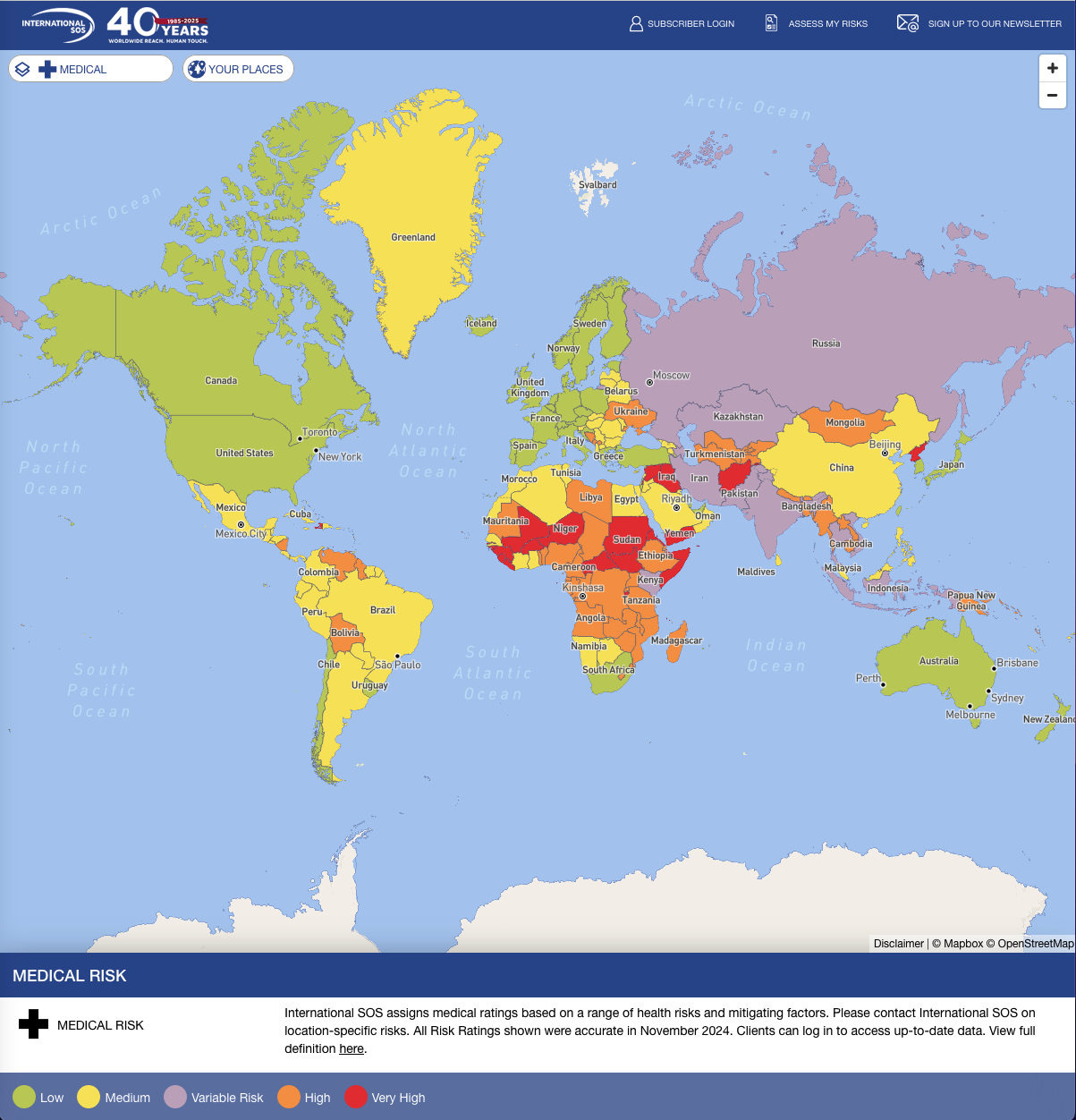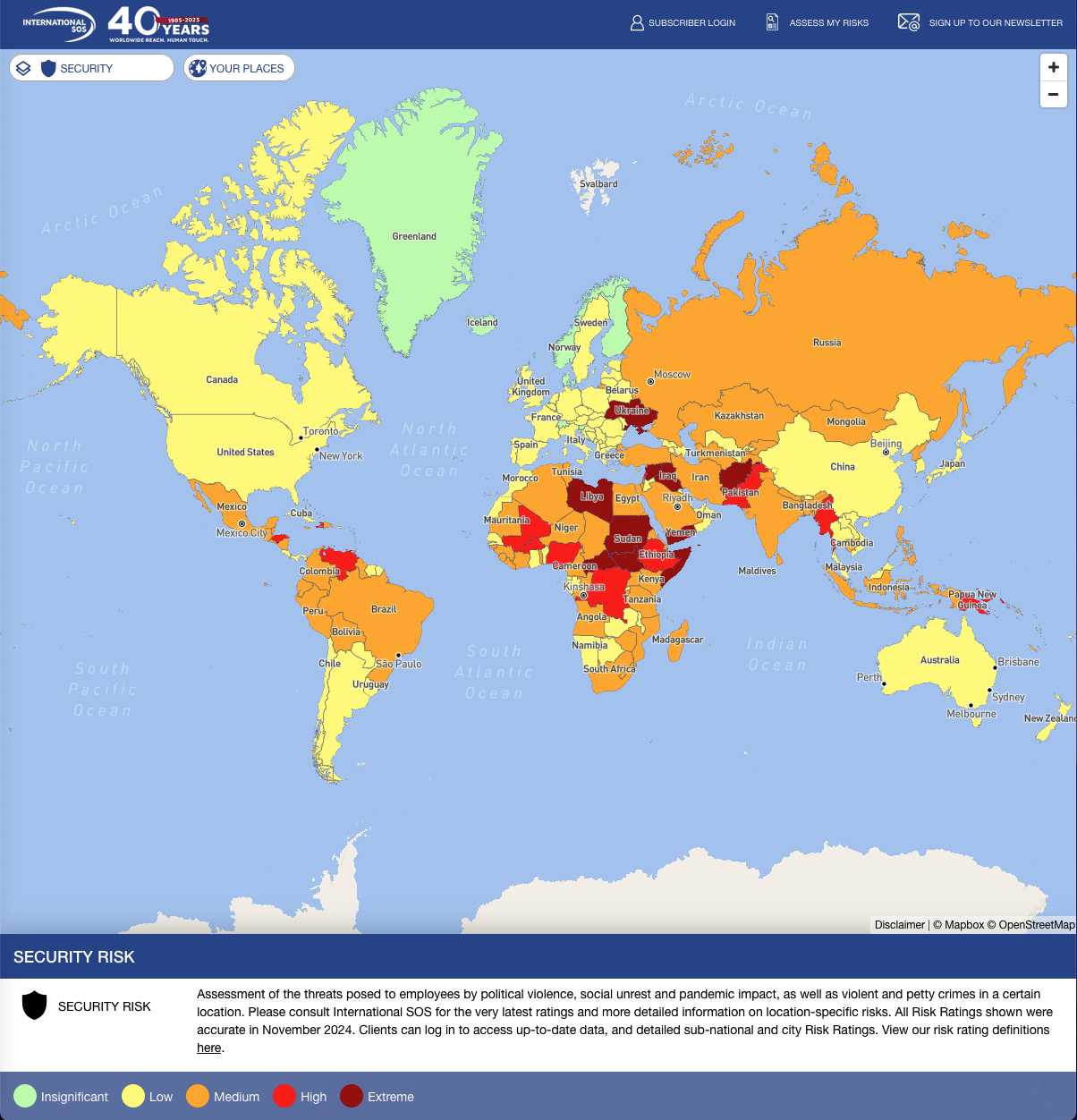When people travel, their safety is usually, if not always, an utmost concern. Travel insurance companies offer policies for medical risks, while international governments watch each other for security risks. Meanwhile, the U.S. government lists travel alerts and warnings to help its citizens plan their travels based on safety risks.
International SOS is a health and security services firm. Founded in 1985 and headquartered in London and Singapore, the privately owned company takes around 3.2 million assistance calls every year and has about 60% of the Fortune Global 500 companies as clients.
From Wikipedia:
International SOS aims to reduce exposure to and mitigate health, wellbeing and security risks for organizations and their staff. Their services include providing a feed of information on world events, assistance services, health consultancy and programs, education, advice and medical equipment. It advises on preventive programs and assisting with emergency response for employees, including domestic workers, business travelers, expatriates and their dependents. Its centers are staffed by physicians, nurses, paramedics, EMTs, security specialists, operations managers, multilingual coordinators and logistics support personnel who speak nearly 100 languages and dialects. It also has a global network of external service providers including specialist doctors, hospitals, ambulances, charter aircraft and security personnel.
International SOS operates worldwide via 27 assistance centers that serve 1,200 locations in 90 countries. They have over 12,000 employees who, combined, speak 100+ languages.
Each year, International SOS releases a color-coordinated map highlighting the world’s most (and least) dangerous destinations. Assessments of threats in any location are based on a variety of factors including:
- conflict
- crime
- infrastructure
- natural disasters
- access to healthcare
- health threats
- air pollution
International SOS then labels each location based on medical and security risks. Here’s what they say about both for 2025:
Medical Risk Ratings for 2025
Potential risk (click here for further definitions):
- Green: Low
- Yellow: Medium
- Purple: Variable risk
- Orange: High
- Red: Very high
“International SOS assigns medical ratings to countries by assessing a range of health risks and mitigating factors, including but not limited to infectious disease, environmental factors linked to climate change, security risk rating, medical evacuation data, standard of emergency medical services, outpatient and inpatient medical care, access to quality pharmaceutical supplies, and cultural, language or administrative barriers.
“An overall single rating is given for a country; however, the medical landscape can vary widely. For example, major cities may have better access to quality medical care, whereas remote or rural locations may have limited availability of health facilities and specialist care.”

“Very high” medical risks for 2023, shown in red, include Afghanistan, Burkina Faso, Burundi, Central African Republic, Eritrea, Haiti, Gambia, Guinea, Guinea-Bissau, Iraq, Liberia, Mali, Niger, North Korea, Sierra Leone, Somalia, South Sudan, Sudan, Syria, and Yemen.
Click here for International SOS’s interactive version of the medical risk map above.
Security Risk Ratings for 2025
Potential risk (click here for further definitions):
- Green: Insignificant
- Yellow: Low
- Orange: Medium
- Red: High
- Maroon: Extreme

“Extreme” security risks for 2025, shown in maroon, include Afghanistan, Central African Republic, Iraq, Libya, Somalia, South Sudan, Sudan, Syria, Ukraine and Yemen.
It’s also noted that only a handful of places received an “Insignificant” security risk for 2025, shown in green: Denmark, Greenland, Finland, Iceland, Norway, Slovenia and Switzerland.
Click here for International SOS’s interactive version of the security risk map above.
International SOS also has maps that outline the risks for climate change and mental health issues.
Feature Image: Michael Theis / flickr / CC BY-ND 2.0
Want to comment on this post? Great! Read this first to help ensure it gets approved.
Want to sponsor a post, write something for Your Mileage May Vary, or put ads on our site? Click here for more info.
Like this post? Please share it! We have plenty more just like it and would love it if you decided to hang around and sign up to get emailed notifications of when we post.
Whether you’ve read our articles before or this is the first time you’re stopping by, we’re really glad you’re here and hope you come back to visit again!
This post first appeared on Your Mileage May Vary

3 comments
Why isn’t Flori-duh red?
They included the US as a whole. So I guess {pick a state} evened it out? 😉
How is Haiti’s security risk not maroon? That seems crazy.